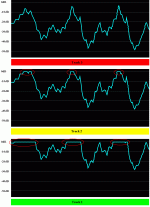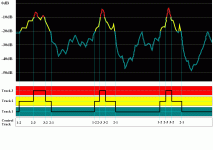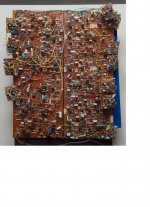I’m more of a speaker guy and far less of an electronics guy, but I’ve had this idea in the back of my mind for a while, and I thought I’d lay out the bones of it, and maybe someone with the required expertise could flesh it out.
In short, the idea is to bring analog tape recording into the new millennium and give it a fresh lease on life by expanding its dynamic range using some of the principles of HDR photography. I’ll be so bold as to dub the resulting system HiDRA (the multiple-head connotation isn’t accidental, as you’ll see).
Here’s an example of what I’m picturing:
Start with a high-quality 8-track studio reel-to-reel tape recorder. With a few tricks, it will become a stereo HiDRA recorder with 20dB greater dynamic range.
Each stereo channel will be built from 4 tracks—3 signal tracks and 1 control track. The input signal will be split 3 ways and recorded to the 3 signal tracks. For track 1, the signal will be unattenuated (0dB). For track 2, it will be, let’s say, -10dB, and for track 3, it will be -20dB.
In a recording scenario, the HiDRA technician will set the recording level so that the loudest passages do not clip the -20dB input. After recording is complete, each channel of the master tape will contain 3 perfectly synced recordings of the event at 0dB, -10dB and -20dB on tracks 1, 2, and 3 respectively.
Now the technician examines the waveform of track 1, looking for the inevitable instances of clipping (remember, recording levels were set ~20dB too hot for this track). He notes the timecode when these clipping events begin and end. He repeats the process, this time with track 2 (which is recorded ~10dB too hot).
Now it’s time to use those timecode notations to record the control track (track 4). All this track does is provide a signal to an electronic switching mechanism on the output, telling it which of the 3 signal tracks is to be heard at any given moment. During quiet passages, track 1 will be passed through to the output. Since it’s recorded ~20dB hotter than normal, its noise floor is about 20dB lower than normal. The instant before track 1 begins to clip, the control track will signal a fast fade to track 2. A moment before the onset of clipping in track 2, it signals a fast fade to track 3. As clipping events end, it signals a return to track 2 and then to track 1.
The net effect is to superimpose the staggered dynamic ranges of the 3 signal tracks, resulting in a total expanded range of ~20dB.
So, whaddaya think?
In short, the idea is to bring analog tape recording into the new millennium and give it a fresh lease on life by expanding its dynamic range using some of the principles of HDR photography. I’ll be so bold as to dub the resulting system HiDRA (the multiple-head connotation isn’t accidental, as you’ll see).
Here’s an example of what I’m picturing:
Start with a high-quality 8-track studio reel-to-reel tape recorder. With a few tricks, it will become a stereo HiDRA recorder with 20dB greater dynamic range.
Each stereo channel will be built from 4 tracks—3 signal tracks and 1 control track. The input signal will be split 3 ways and recorded to the 3 signal tracks. For track 1, the signal will be unattenuated (0dB). For track 2, it will be, let’s say, -10dB, and for track 3, it will be -20dB.
In a recording scenario, the HiDRA technician will set the recording level so that the loudest passages do not clip the -20dB input. After recording is complete, each channel of the master tape will contain 3 perfectly synced recordings of the event at 0dB, -10dB and -20dB on tracks 1, 2, and 3 respectively.
Now the technician examines the waveform of track 1, looking for the inevitable instances of clipping (remember, recording levels were set ~20dB too hot for this track). He notes the timecode when these clipping events begin and end. He repeats the process, this time with track 2 (which is recorded ~10dB too hot).
Now it’s time to use those timecode notations to record the control track (track 4). All this track does is provide a signal to an electronic switching mechanism on the output, telling it which of the 3 signal tracks is to be heard at any given moment. During quiet passages, track 1 will be passed through to the output. Since it’s recorded ~20dB hotter than normal, its noise floor is about 20dB lower than normal. The instant before track 1 begins to clip, the control track will signal a fast fade to track 2. A moment before the onset of clipping in track 2, it signals a fast fade to track 3. As clipping events end, it signals a return to track 2 and then to track 1.
The net effect is to superimpose the staggered dynamic ranges of the 3 signal tracks, resulting in a total expanded range of ~20dB.
So, whaddaya think?
By the way, in case it wasn't obvious in the description, the playback level of each signal track would be adjusted to cancel the relative offset. So track 1 would be attenuated 20dB, track 2 would be attenuated 10dB, and track 3 would be unattenuated. Just to be perfectly clear. 
Last edited:
This technique of cutting between parallel tracks recorded at different levels needn't be limited to analog tape. It can be used to push down the thermal noise floor of analog electronics and maximize useful bit depth in digital recordings, too. I believe Ray Kimber does something similar in the digital realm with his IsoMike recordings, where he overlays clipped segments with clean ones from an attenuated track in a digital nonlinear editor.
That's fine and dandy in the digital realm, but typical editing in the analog realm introduces compromises due to generational losses. The advantage I see with the HiDRA magnetic tape scenario outlined above is that no generational losses are incurred. The control track and output switching device direct the playback of first-generation signal tracks, so maximum purity is preserved. With high-quality hardware and tape, a 4-tracks-per-channel HiDRA setup should be capable of about 100dB of useful dynamic range. That's higher than the ~96dB of a 16-bit compact disk.
If you want to get really crazy, you could extrapolate the HiDRA system ad-absurdum to many more tracks per channel, up to 24 tracks on 2-inch tape, for 150dB+ of virtual dynamic range--more than the best microphones are capable of. The sky is the limit.
The technical requirements of the HiDRA system don't seem too daunting. The key novel components are the control track and the output switching device. The control track/switch could be analog or digitally controlled.
I imagine the switching between tracks should probably be a very brief cross-fade of a fraction of a second vs. instantaneous to avoid audible switching artifacts. The duration could be optimized with a little experimentation.
That's fine and dandy in the digital realm, but typical editing in the analog realm introduces compromises due to generational losses. The advantage I see with the HiDRA magnetic tape scenario outlined above is that no generational losses are incurred. The control track and output switching device direct the playback of first-generation signal tracks, so maximum purity is preserved. With high-quality hardware and tape, a 4-tracks-per-channel HiDRA setup should be capable of about 100dB of useful dynamic range. That's higher than the ~96dB of a 16-bit compact disk.
If you want to get really crazy, you could extrapolate the HiDRA system ad-absurdum to many more tracks per channel, up to 24 tracks on 2-inch tape, for 150dB+ of virtual dynamic range--more than the best microphones are capable of. The sky is the limit.
The technical requirements of the HiDRA system don't seem too daunting. The key novel components are the control track and the output switching device. The control track/switch could be analog or digitally controlled.
I imagine the switching between tracks should probably be a very brief cross-fade of a fraction of a second vs. instantaneous to avoid audible switching artifacts. The duration could be optimized with a little experimentation.
Last edited:
no, its just rather pointless to propose "improvements" to analog tape performance at this point in recording history - those (few) concerned already have gone to custom machines with extra wide tracks and high tape speed for greater S/N, dynamic compression schemes for the single track signals already exists with decades of market acceptance
today only a few SOTA analog tape machines are in use - most studios use restored decades old machines to add "analog tape sound" as an effect - and use hi-rez digital for accuracy and mastering convineience
today only a few SOTA analog tape machines are in use - most studios use restored decades old machines to add "analog tape sound" as an effect - and use hi-rez digital for accuracy and mastering convineience
Last edited:
Ah! A taker!
So, you're saying it's like hot-rodding a steam engine for Formula One--I shouldn't waste time on an obsolete technology? I guess I'll concede the point, though it sorta sucks the fun right out.
Okay. Sounds good. But perhaps my little scheme could accomplish even highter S/N using OEM equipment for less dough than a one-off machine? Just wondering...
I may be misunderstanding you here, but I'm proposing quite the opposite of a dynamic compression scheme--I'm aiming at essentially zero compression.
Yeah, I was wondering about that in the back of my mind. This HiDRA idea is predicated on the supposition that analog tape brings something useful to the table performance-wise that digital does not. I've heard people rave about the absolute playback fidelity of analog master tapes and how it is so much more true-to-life than digital. But the skeptical little devil on my shoulder reminds me that people in general often perceive euphonic distortion as improved fidelity.
If that's really the dirty little secret behind the cult of analog tape, then I'll waste no more time on this HiDRA beast.
So, you're saying it's like hot-rodding a steam engine for Formula One--I shouldn't waste time on an obsolete technology? I guess I'll concede the point, though it sorta sucks the fun right out.

those (few) concerned already have gone to custom machines with extra wide tracks and high tape speed for greater S/N,
Okay. Sounds good. But perhaps my little scheme could accomplish even highter S/N using OEM equipment for less dough than a one-off machine? Just wondering...
dynamic compression schemes for the single track signals already exists with decades of market acceptance
I may be misunderstanding you here, but I'm proposing quite the opposite of a dynamic compression scheme--I'm aiming at essentially zero compression.
today only a few SOTA analog tape machines are in use - most studios use restored decades old machines to add "analog tape sound" as an effect - and use hi-rez digital for accuracy and mastering convineience
Yeah, I was wondering about that in the back of my mind. This HiDRA idea is predicated on the supposition that analog tape brings something useful to the table performance-wise that digital does not. I've heard people rave about the absolute playback fidelity of analog master tapes and how it is so much more true-to-life than digital. But the skeptical little devil on my shoulder reminds me that people in general often perceive euphonic distortion as improved fidelity.
If that's really the dirty little secret behind the cult of analog tape, then I'll waste no more time on this HiDRA beast.
Ackcheng,
Thanks! No, I haven't tried anything yet. Just wanted to get the idea out for some feedback.
Greenvalve,
It would indeed be a compressor if the relative gain offset in the signal tracks wasn't compensated for on playback. Without this compensation, upon fading to track 2, there would be a sudden 10dB drop in relative SPL. I wasn't very clear about that in post 1, that's why I followed up with post 2.
In my example, track 1 is recorded at 0dB, track 2 is recorded at -10dB, and track 3 is recorded at -20dB. On playback, their relative levels are restored: track 1 is attenuated 20dB, track 2 is attenuated 10dB, and track 3 is unattenuated. So now, when one track runs into its dynamic ceiling (clips), you can seamlessly cut to the next track, and dynamics can keep climbing.
Thanks! No, I haven't tried anything yet. Just wanted to get the idea out for some feedback.
Greenvalve,
It would indeed be a compressor if the relative gain offset in the signal tracks wasn't compensated for on playback. Without this compensation, upon fading to track 2, there would be a sudden 10dB drop in relative SPL. I wasn't very clear about that in post 1, that's why I followed up with post 2.
In my example, track 1 is recorded at 0dB, track 2 is recorded at -10dB, and track 3 is recorded at -20dB. On playback, their relative levels are restored: track 1 is attenuated 20dB, track 2 is attenuated 10dB, and track 3 is unattenuated. So now, when one track runs into its dynamic ceiling (clips), you can seamlessly cut to the next track, and dynamics can keep climbing.
It seems to me that you could get comparable results with a mild constant compression ratio across a wide dynamic range (perhaps 1.2 - 1.5: 1) and go with wider tracks on the same tape. I've already built vacuum tube record and playback electronics that have linear phase response and group delay characteristics from the LF cutoff to past 20khz at tape speeds of 7.5 ips and higher plus a tube peak unsaturator that reliably adds 2-3 db of head room extension across the frequency band in playback. Plus, boosting the record bias frequency to 300khz or greater appears to lower the noise floor by a couple db.
Last edited:
Sorry - I forgot to mention that there would be a complementary expansion ratio in playback - nothing so drastic as DBX and much higher SQ, of course. Also, with constant group delay and the flat response of a professional machine, it may be feasible to virtually dispense with compression and expansion time constants.
Here's an illustration of how the three signal tracks are recorded in my 4-track HiDRA example. Levels are set not to clip track 3. Tracks 2 and 1 have clipping (circled), but they are intended to provide signal only on quieter passages where their hotter levels provide higher S/N.
Attachments
Dolby SR noise reduction (been around for 20 years).
Is there any reason that a HiDRA machine couldn't also use Dolbe SR? Or is the pursuit of a lower noise floor not worth the trouble?
And tape dosnt clip it saturates (which causes compression/limiting) which is part of the "tape sound"
True. Please mentally edit my illustration to show a saturating waveform instead of a clipping one.
(BTW, is it crazy that a big part of the HiDRA idea is to eliminate the distortions that are part of the "tape sound?")
Last edited:
Wow! How's that for a little bit of light circuit design?
(Dolby SR breadboard image from Wikipedia)
Way overly complex, IMO. And I bet I could do it with the signal path through only vacuum tubes
(BTW, is it crazy that a big part of the HiDRA idea is to eliminate the distortions that are part of the "tape sound?")
Only to somebody who is only interested in analog tape as a 'sound effect'.
Last edited:
Wont work the way you are thinking. The analogy is all mismatched for one but I do see advantages to say matrix micing. But this isn't exactly something new to the studio world analog or digital. And I would think digital has the upperhand in signal to noise ratio. But basically anytime you add these tracks together you are going to get more noise not less - no real way around it sorry.
- Status
- This old topic is closed. If you want to reopen this topic, contact a moderator using the "Report Post" button.
- Home
- Source & Line
- Analogue Source
- HiDRA (High Dynamic Range Analog) What if . . . ?


